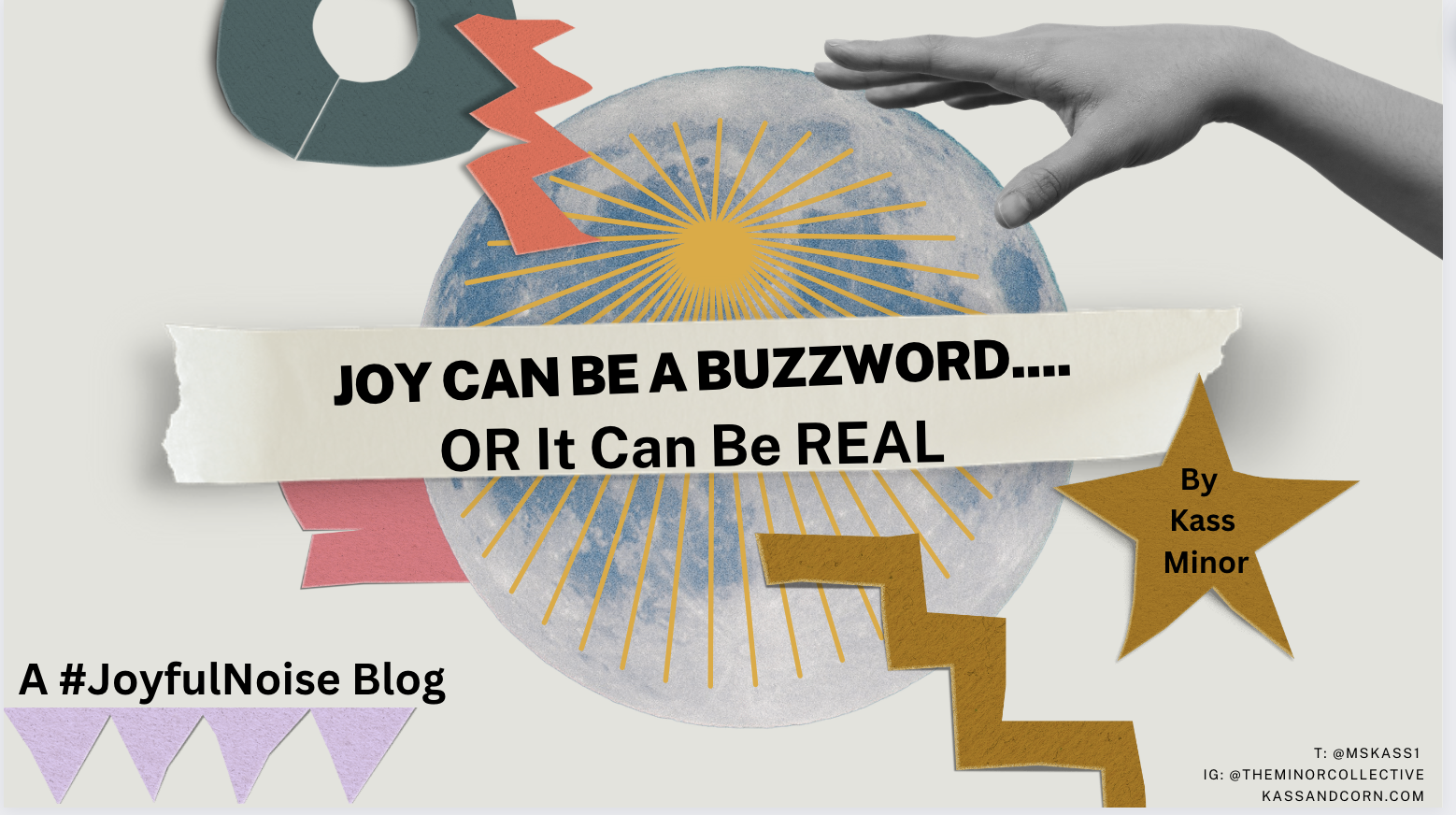Generating a Dream Together: On Future Goodness
On March 8, 2025, Kass and Cornelius teamed up with their beloved friend, world-renowned poet, and Emmy-award winning producer, Kwame Alexander, to gather with educators from all over. They gathered, they shared, and most urgently-they generated an active dream together. After exploring The Structured Generator for Hope from Teaching Fiercely, the community wove together thoughts, ideas, and poignant words. Curated by Kwame Alexander, lovingly held by Kass, Cornelius, and countless educators named below, they offer the poem below for all to read, hold tightly, and act! They look forward to more Action Dreaming with educators this summer. Stay tuned!
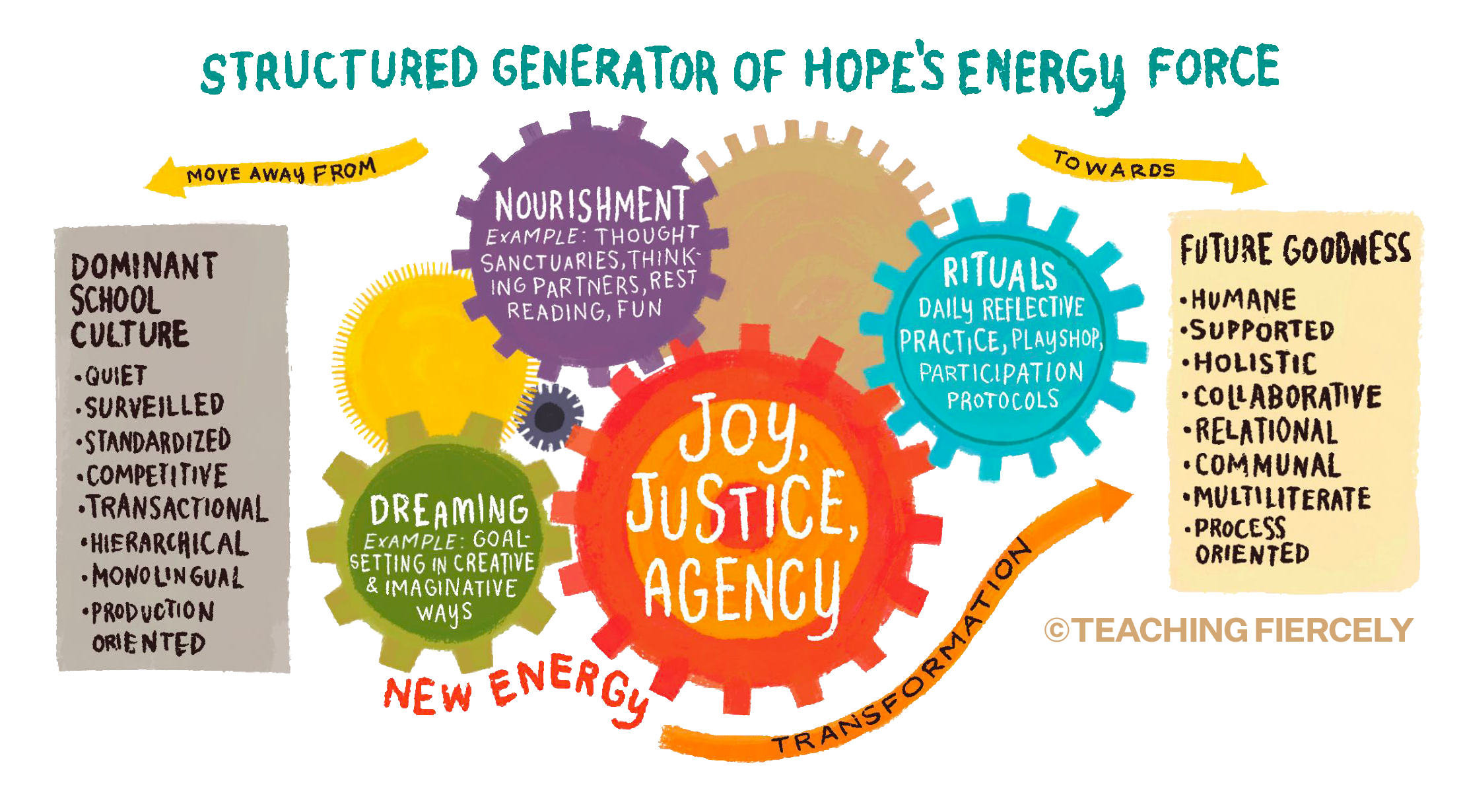
Future Goodness
Or, there’s more power in people
than people in power
A community poem by the Action Dreaming community of educators, March 8, 2025
composed by Kwame Alexander, with words from Jennifer Baldocchi,
Eti Berland, Allison Blount, Erika Bogdany, Melissa Boire, Suzanne
Bouffard, Charita Brown, Laurie Burke, Joy Canning, Lynn Clements,
Gregory Croft, Jaime Gerding, Megan Gilligan, Stephanie Hendrix,
Michelle Jewell, Maria Johnson, Vanity Jolly, Evie Katz, Sandra Levin,
Sue Mayo, Janet McDowell, Cornelius Minor, Kass Minor, Mary
Moorman, Gail Harper Morris, Sarah Norsworthy, Amy Okimoto, Brian
Pahl, Judy Pak, Cheryl Piccirelli, Rachel Posner, Skylar Primm, Rose
Reissman, Stephanie Rich, Nicole Scott, Teresa Setzer, Jaimee Taborda,
Markesha Tisby, Darcie Wirth, and Ruth Whitney
Future goodness is soft smiles, loud stomps, mischievous chatter, swoons, thumps of
laughter, dog eared pages and paint stained fingers infinite questions.
Future goodness is not just the really big things. It’s the little things, it’s the result of
having each person’s humanity acknowledged in community,
saturated in compassion and justice
is laughter, liking, love, loosening, leading links to life,
lighting to literacy, literacy, liberty, leader.
Future goodness is what we feel when what we see and hear does not hurt.
Is this aching smile on the tip of my heart’s tongue
knowing the imperfectly human. you belong here with the messy human me, the not
knowing waters, the growth and the tiny tendrils connect through the space, breath by
breath in moments
Future goodness is listening…
an open heart…
standing beside each other…
is weaved among moments of connection that break through the noise and the chaos.
Future goodness is the sigh released after being fully seen, heard, witnessed…
is the breath of the present, the inhale of what is
and the exhale of what will be
sometimes shallow, sometimes deep.
Future goodness is in the breath born of our seen selves…
is an early morning laugh with a science teacher when the copier fails,
that machine stays broken.
our spirits do not have to.
Future goodness knows that good teaching is not on the paper.
Future goodness knows that good teaching is not on the paper, gives thought to
thoughtfulness, and cares for one another. it draws strength from hopelessness, and
passes hope to your brother.
Future goodness is built one small step at a time. It’s built on kindness offered and
accepted.
Future goodness is our children…
is our children who have been mentored by we, the adults who care, support, resist
quietly, loudly, daily, weekly.
Future goodness is in the moment we want to crawl into ourselves and simply live there
until it all passes. Instead, we unfurl ourselves, align our shoulders, tilt our heads up,
and crawl toward it.
Future goodness is seeing the best
in everyone, seeing the passion in the child who acts up …
is togetherness in a diverse world of thought.
Future goodness is connected humans caring for one another.
Future goodness is love
unabashed and revolutionary…
is staying strong and loving
defiantly onward…
is the genuine care felt in the space that honors…
Future goodness is quiet, the heart beating in our chest living within us.
laddering lush lamination…
is heart, small actions that thump, thump, thump, is every child feeling love…
is the strength of a smile …
is building bridges with books…
is creating safe spaces for our children…
is teachers, finding and supporting community amongst themselves
to foster and strengthen their own self care.
and learning is a prayer… is believing in every child
and every child feeling love…
is finding love…
is finding love…
in growing minds and strengthening hearts.
Future goodness is starting now.
Thoughts For the New School Year, from Cornelius
transcript below
When I was in 7th grade, the original Jordan Vs came out. Not the retros, but the actual Vs. For those of you doing the sneaker math right now, yes I am officially one of the old heads… I don’t know when I acquired that status. All I know is that it’s the first week of school in New York City, and even though I had a whole summer to learn, I still don’t know what “skibbidy” means. Kids don’t call me bro no more, they stop by the room and call me unk. I’m uncle status now. I guess that’s a good thing… It gives me license to tell stories, cause that’s part of what uncles do. So I’m starting this reflection with a story.
Back when them jordans came out, I needed them. The Vs had that translucent bottom and the iridescent tongue with the logo. It was some year 2000 type stuff, but in 1991. I cannot overstate this. I needed them. And I had one of those black mamas who was not going to spend $100 on shoes. So I did what nerdy kids do best, I created a plan to sidestep authority by doing chores for neighbors and relatives to raise the money myself. She wasn’t going to spend $100, but I was… It took me almost four weeks to raise the cash — $105.35 to be exact. I kept in in a transformers wallet, and on the morning when I asked her to take me to the Foot Locker, my mother hit me with a classic “mama” line of questioning…
“Do you really want to spend ALL your money on shoes? …you worked so hard to save that much…”
“Mom I NEED them. All my friends got them.” This was a lie. None of my friends had them… Just that one kid, Scott, from the other side who I didn’t really even like… I did not need the shoes, what I really wanted was to flex on Scott. But I was not mature enough to admit this to myself or to my mother in 1991.
My mom hit me with the Black mama hypothetical then… “If all your friends are jumping off a bridge, are you gonna jump off too?”
I think about that question often.
…As I mature as an educator I’m so thankful for all of the things that this profession has generously given me — friendships, community, and opportunity to grow, to stand for something — and I’m also increasingly vigilant about the things that it forcefully takes… Though, I guess this could be true about any profession, being an educator in a society that is not always people-centered has drained me of energy, of time, and of personhood in ways that have been hurtful. My whole career, I’ve tried to do whatever was asked of me by my city, my district, my school — even when it seemed to be in conflict with what children, families, and communities needed. …or in conflict with what I needed. I want to be a good employee. And I’ve had to do this while asserting the value of black life, demanding access for immigrants and folks with disabilities, centering the humanity of my LGBTQIA siblings, and reminding a whole country that their thoughts and prayers are not enough when whole communities of children are plagued by gun violence.
It’s a lot.
I’ve lost myself to this before — in unhealthy ways, and as I start this school year I’m realizing that I don’t want to lose myself again. There is so much about this work in education that gives me life, AND I have so much to live for outside of it.
Grinding every day to do what everyone wants or expects will have you out here not being yourself… It took me all summer to journey back to myself, and I’m learning to love me enough to stay me… even when the world demands otherwise.
These days, I’m asking the question: How do I return to work — which is beautiful — without returning to the grind — which depletes me. How do I deepen my connection to myself?
To better explore this, I had to consider the things that diminish my connection to myself…
Achievement culture / Perfectionism
People Pleasing
Taking on too much
Trying to fit in
Not standing up for my ideas or my ideals
Not working to my full potential — by my standards, not anyone else’s
Interrogating these things in public is hard… Institutions in capitalism are built to run efficiently and pausing to reflect on my tendency to take on too much or abandoning sharp perfectionism for the boundless imperfection of actual professional growth slows that efficiency. It would be much easier to say yes to all the mandates without question… Do I really need to take on that extra thing or is the overachieving people pleaser inside me doing it just for the flex?
Everyone else is doing it.
And I hear my mom’s voice again.
“If all your friends are jumping off a bridge, are you gonna jump off too?”
It’s been 33 years since I was in 7th grade. My name is Cornelius Minor, I’m a Brooklyn based educator and, though I have not always been certain of my answer to that question when it comes to following the crowd or the trend or the fad of the year at work… I am certain of my answer now.
I’m not jumping, I’m trying to maintain the fortitude to be me. Imperfections and all. Happy new school year.

*resources included*
I recently worked on a project where I was asked to revamp New York State’s “Portrait of a Graduate,”a collection of characteristics that NYS wants reflected in all high school graduates by the time they finish school. I interviewed a variety of people close to the school system, one of whom was a recent high school graduate. I asked her: If you could have taken a class in high school that didn’t exist when you were a student, what would it be and why? And then I listened.
First, she talked about needing a “How to do life” class to learn more about financial literacy, health insurance, how to get a driver’s license, etc. (I silently concurred as I am still learning how to navigate my 401K and healthcare bills). I continued to listen as she grew more passionate discussing what she really needed from school in this “How to do life” class: a way to navigate and interact with people from different backgrounds, who have completely different lived experiences and different politics than what you’ve experienced, let alone been exposed to. She said: We’re so polarized. We don’t know how to speak to each other. I don’t know how you teach that, but maybe high school would be a great place to learn. As I listened to this wise twenty-something, I thought to myself: Yes. AND it can start much earlier than high school. AND it’s not too late for those of us who are done with school all together.
Maybe always, schools have been incubators for young people’s socialization. Starting in PreK, kids learn what they are supposed to say and how to react. Years go on in their school lives, and they learn what kinds of silences are rewarded and what kinds of speaking up is punished. The educators that teach them live in a space of constant negotiation between their personal belief systems, commercial curriculum, research-based practices, and school community values. Global and local realities evolve. From climate change to elections to book-banning to multiple wars, these realities have been seismic in their shifts. Families work to protect their kids and promote the ideas they think are best.
As I write this, it is the first day of school in my hometown, Brooklyn. My own children go to Public School, and while I am in community with their friends’ families, their teachers, their school leaders, as well as a few local politicians, authors of the books they read, the curriculum they learn from, and the research that drives ed policy, a variety of perspectives pop up, and we’re not always in agreement with how things should go. However, when there is genuine effort to truly open conversations, I am heartened by the teaching and learning that happens when people really listen to one another. These exchanges are typically outside of media, digital mediums, or formal meetings. Rather, they take place in coffee shops, the in-betweens of commutes, and phone calls after kids are in bed. I will also say, I still don’t know how to talk to everybody, and as challenging as dissent may feel, I am almost never silent about the harm I bear witness to. I’m not always popular.
[Note: this doesn’t mean I engage in negotiating one’s right to exist. There are times when the conversation is simply closed; where instead, action is warranted.] [I do not have all the answers.]
The duality of emotions is real. I feel wounded by the disregard for others’ humanity; I am not all the time hopeful. However, I am, at this moment (and historically), relentless in my pursuit to continue the conversation on what it means to center the humanity of children in our schools–regardless of others’ market-driven or fundamentalist ideas on what constitutes “good” schooling.
The recent high school grad I interviewed said she didn’t know how we teach people with different worldviews to engage. While I can’t say I have any fool-proof methods, I can say I have an idea where to start, beginning with a question educators and students are rarely asked: What do you believe in?

I know! It feels big. But I’ve thought about this a lot, and have used it for myself and many school communities. The dialogue this questions fosters is immense, and I offer a protocol to contain it for school-based purposes: the Shared Vision Planning Page. Originally created by educator Elizabeth Stein for co-teachers, I revised this “Shared Vision” protocol (featured in Teaching Fiercely: Spreading Joy and Justice in Our Schools, p. 130, linked here and also shown on the left) to surface our philosophies on what it means to teach, and perhaps more importantly, what it means to learn.
Whether or not you self-initiate this reflection or you are facilitating it with others, it’s a powerful exercise that can evolve throughout the year, serving as a point of reference for who you are, what you believe in, and what you are working towards. Some schools I’ve worked with start this work at the beginning of the year, and revisit it every time they meet together, using it as a litmus test for decision-making that happens throughout the year.
I invite you to process your beliefs with the folx who work alongside you, continuing the commitment in doing our best, doing right by kids.

As the school year completes another circle around the sun and Teaching Fiercely has its first birthday, I find myself in a space of critical reflection. I don’t, necessarily, feel a sense of relief. For me, one of the most beautiful aspects of educator life is the cyclical renewal we’re able to experience with the tides of summer break rolling into a fresh school year. This Summer, however, feels loaded. Not in a bad way, but in a way that calls me, hopefully us, into action.
We are headed into Fall with both opportunity and challenge. How can we use our time in the coming months–this precious time without school in session–to rest, to connect with our families, while also experiencing joy in preparing for what lies ahead? For me, this duality starts with a solo thought sanctuary and leads to communal reflection. Later, we find time for action–and we never do it alone! Below, I’ll work through some of my personal reflections. I share this in hopes of reflecting with folx communally later this summer.
- Finding time to bathe in silence makes a difference.
Recently, at a talk I attended between Questlove and Marc Lamont Hill, Questlove beckoned the COVID period as a space where he was able to work without other people’s “noise” affecting his decision-making processes, especially as it pertained to his confidence in his ability to execute a particularly creative idea. He used the exact words, bathing in silence, to describe this phenomenon. I remember this period too! For many of us, life was harsh, yet, it also offered new ways of being in how we work and with whom we work.
This makes me think of life in school. It is of course influenced by A LOT of outside noise. But I’ve found when educators are able to lean into their inner life, or the most intuitive ideas, they feel more confident that those ideas will make a difference for their well-being and their students’ learning. This is certainly true for me, and there’s a ton of research to back this up. (I’m currently working on filling up this research bucket too!). Moving into the summer, I wonder: How might we find time to immerse ourselves in our own ideating, waving off outside deterrents that take away our confidence and our ability to brainstorm without doubt?
Action item: Read something YOU choose. Write a six-word story, nearly everyday if you can, about anything related to your educator-life.
2. Care and comfort are not the same thing.
Human beings, like any other mammal, are creatures of comfort. Our bodies are hard-wired to seek non-threatening environments. This is a challenging context when working towards justice because it requires people to unlearn what they have previously known as safety. For example, schools have been accommodating for many folx who grew up in dominant culture; traditional schooling norms like raising your hand, sitting still for 45 minutes, or hosting in-person PTA meetings feel normal, i.e. non-threatening; comfortable.
Conversely, for folx who come from non-dominant cultures, including BIPOC, LGBTQIA+, dis/abled, unhoused, immigrant status, non-English speaking, and more; much of what is deemed non-threatening via tradition is indeed threatening for those groups. The hand-raising, for a child who feels shy about sharing their emerging English, threatens their confidence. The stillness, for a child with neurological conditions that affect their physiology, threatens their well-being in the classroom. The in-person PTA meeting, for an unhoused parent, is two hours away from the shelter they are staying at, this threatens their ability to engage in school activities. Race, gender, and sexuality complicate each of these situations even more deeply.
So, what I’m saying here, is that we must challenge groups who demand comfort in place of caring for our school communities holistically. Sometimes, that means engaging in a great deal of discomfort, disproportionately, for those groups who feel like school is safe. (This is often white, well-resourced families, or well-resourced families who are well-versed in navigating whiteness).
Action item: Quiet reflection on your own: How comfortable do you feel in school? What does care mean to you? Choose to document on your own, or call a friend (who shares some type of affinity with you) and share.
3. Working alone is for the birds.
Look, when Cornelius and I started The Minor Collective in 2018, I had never spent any amount of time managing a business. All my waking hours were immersed in beautiful school communities, my own classroom, and nurturing my very young children. These days, I find myself entangled in the muck of industry and bureaucracy, in the banter of other people’s classrooms (both joyful and fraught), and on the other end of a phone line, listening to both fresh ideas and frustrating, archaic challenges with schooling. Each one of those examples is attached to a 500-page story, and I know I am blessed with opportunity and friendship and radically hopeful communities, but this world doesn’t change with “I”. Rather, it moves with “we”.
I share these snippets with you because I know everyone in education is entangled in some kind of muck, and it can feel intensely isolating. What I have learned, more than anything, is that the more your try to disentangle yourself on your own, the further you will glide into that muck. However, the more you make yourself vulnerable, connecting with even just one other person, the more likely you are to find some Wellies and make a road by walking towards dryer ground.
Action item: Identify a few people in your life that you can easily connect with to work side-by-side, share what you’re doing, or even asynchronously share and respond to a few working goals.

Authors Note: “Teaching Fiercely: Learning Lifeways” is a new series of pop-up posts sponsored by The Minor Collective. This learning series showcases lifeways demonstrated in school communities, developed from Teaching Fiercely Partnerships with Kass Minor. These posts feature the praxis of Fierce Educators around the Globe. Stay connected and share widely! Have a thought sanctuary of your own? The Minor Collective invites you to share via email at info@kassandcorn.com, or tag us on social media via @theminorcollective #TeachingFiercely #thoughtsanctuary
Educators across the globe strive to develop joyful learning in all kinds of school environments. From Pre-K to secondary school to higher ed, teachers are navigating landscapes that don’t always speak to their needs or their community’s needs. When I composed Teaching Fiercely, I didn’t write it from a place of maybe, I wrote it from a place of this is what people are doing in school right now that maybe others can benefit from too. (While also making space for expansive imagining and dreaming too!)
This I know for sure: When school communities work together to create space for both teachers and kids to show up as their whole selves, there is a greater probability that justice will emerge. To do that work in a bounded system like school, there’s a little cognitive architecture involved! To start finding common ground within a school community, I’ve provided some language and examples through the concept of thought sanctuary, featured in Chapter 3: A Framework for Social Justice Work in Schools and Gentle Notes on Learning in Teaching Fiercely: Spreading Joy and Justice in Our Schools.
What is a Thought Sanctuary?
Thought sanctuaries allow for educators to gather and think safely, even joyfully, within their lived experiences in school. While the word “sanctuary” is often associated with holy, spiritual, and/or religious connotations, its meaning also extends to a space that provides safety and protectiveness from danger. Teaching Fiercely describes thought sanctuaries in four ways.
- Thought Sanctuaries are spaces within or outside a school where your needs are met.

Teachers gather virtually every Friday to enjoy a space of care, critical thinking, and shared values.
Two groups of educators in completely different communties I’m in partnership with have created this experience: They share similar values but work in different schools, so they created a ritualized virtual meeting (every now and then in person) every Friday! There, they meet in the name of “book club.” But the space is so much more than that–it is centered on connection, commitment, and sharing the fullness of their teaching lives. Ultimately, it serves as a place to decompress and to share joy and often, exhaustion. It is also a wellspring of care for themselves and one another.
2. Thought Sanctuaries are spaces where joyful curiosity is enabled.
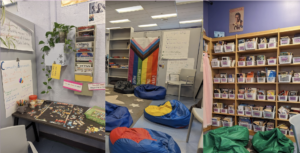
A former middle school technology room turns into a different kind of gathering space.
One middle school transformed their technology room into a suite that caters to both students and teachers’ playfulness and restoration. Teachers have curated the room with multiple “center” like attributes, including puzzles and games where students can spend time during lunch. This gathering space also includes an evolving justice-oriented library, and even a meeting space for teachers to come together to work on everyday planning! They’ve also utilized this room for specialized planning for restorative justice initiatives.
3. Thought Sanctuaries are spaces that underscore the value of flexible thinking and loose or absent agendas.
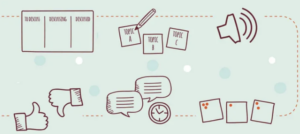
Photo Credit: Philip Rogers from leancoffee.org. An example of a “lean coffee” process.
There is a lot of pressure to “deliver” when it’s time for PD. It’s also an extraordinary task to organize PD that makes sense for all educators in any given community. That said, a few schools I’m working with have begun to put trust in teachers’ hands when creating agendas for staff clerical days or designated teacher learning time. Loose agendas are a tough transition for a highly structured space like school. However, when meetings are facilitated with intention and purpose, the use of protocols to reclaim learning time, especially for teachers, works really well. It also frees up time for school leaders! Teaching Fiercely Partners have been using “Kid Talk” as well as “Lean Coffee” protocols.
4. Thought Sanctuaries are spaces that pair well-being with ideation and creativity.
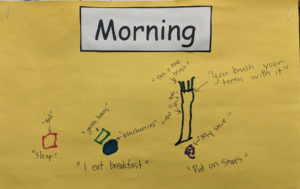
A Pre-K student documents their morning wellness routine.
Creativity is a cornerstone of joyful learning, and too often, it is inhibited within the parameters of third-party expectations. Even so, many people whom I’ve been in partnership with in a variety of school communities have committed to developing time and space that is underscored with creative energy and opportunity. In a PreK classroom in Brooklyn, teachers have committed to helping children understand the importance of naming “wellness” in their lives. They don’t just talk about it, the create about it!
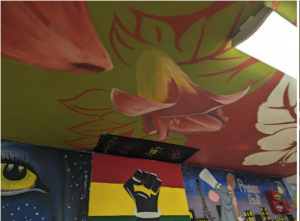
High School seniors in the Midwest paint murals that represent their interests and communities in a dedicated hallway.
A high school in the Midwest dedicated an entire hallway for their seniors (every year!) to create art that represents their culture, interests, and communities. Even the ceiling is well-documented with the imprint of adolescent hearts from years past.
A fellow educator recently asked me how I find energy to locate joy in school, especially in months like March and April where so much of learning is swept up in high-stakes testing. When people don’t have what they need. My response: I keep on working to transform the conditions people are working in, and I don’t try to do it alone. I continue the pursuit (As Dr. Gholdy Muhammad might say!) to find joy in the synergy I experience when I collectively strive to create spaces where people can care for one another deeply, where teachers are able to exercise their thinking in ways that are full of support and connectivity to kids, and where play and rest can take root. The examples above are just a few ways people in schools have been able to practice the demonstrative care necessary to enable something as powerful as a thought sanctuary in a teaching and learning context.
To learn more about thought sanctuaries, consider reading Teaching Fiercely: Spreading Joy and Justice in Our Schools, Chapter 3: A Framework for Social Justice Work in Schools and Gentle Notes on Learning by Kass Minor.

People are always asking me, “What is it that you do, Kass?”. It was so much easier when I could just tell people, “I’m a teacher.” So, I’ve been working on more clarity in this conversation. Here goes: officially, I am the co-founder of #TheMinorCollective, a community-based movement designed to foster sustainable, equitable change within the ecosystem of school. My most recent bio entitles my role as “educational strategist” “instructional coach” and “former classroom teacher”. But unofficially: I am simply a committed person who has never lost sight of kids, teachers, and the beautiful opportunities that are loaded with potential when communities are able to intentionally, holistically, and collectively implement people-centered experiences within schools. That is what I do, and this is what some of that #TeachingFiercely work looks like across the country. I invite your to explore #TeachingFiercely further, and consider partnering with me as we look ahead into 2024.
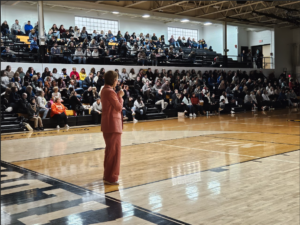
Kass with Sylvania School District Educators, Jan ’24.
1. Ohio. In early January, I had the pleasure of working not just in my home state, but in my home region of Northwest Ohio. (Shout out to OHEA!). We often think of the differences between the coasts and the central parts of this country when we examine educational paradigms, and don’t get me wrong–there are many. But as I set foot in Sylvania High School’s gymnasium to talk about spreading joy and justice and Teaching Fiercely with 500+ educators, I was reminded that most educators are committed. Most educators want robust and joyful learning experiences for kids, regardless of where they live.
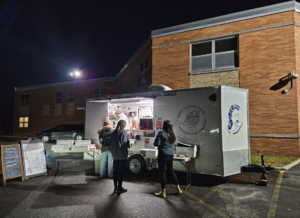
Sylvania School District Hosted an OPEN COFFEE BAR starting very very early before the PD day began.
And while their circumstances are indeed very different, in this State, in this region, there were bunches of Ohioans who reminded me of so many Soul-to-Earth types that I grew up with. In Ohio, there’s no pomp and circumstance. It’s reality underscored with doses of humility, and many times, getting back to work. Case in point: you know how weddings have open bars? At this PD, the District organized an OPEN COFFEE truck bar, which is essentially this coffee lover’s (along with many other Ohio T’s) dream come true!
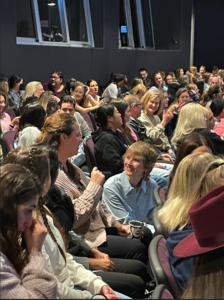
Kass, working with Irvine Unified Elementary School Educators, Feb ’24.
2. California. Until recently, I’d only been to Cali in two capacities: for education conferences or to visit friends in the mountains of San Francisco or Hills of LA. This February, I was invited to partner with Irvine Unified School District, and work with ALL the elementary school teachers in their district to consider Teaching Fiercely, and especially, to unpack what it really means to implement Culturally Relevant and Sustaining Practices and Language Justice. I was particularly touched by the educators who worked to organize the conference, intentionally centering the expertise of local educators to underscore the idea (one of my favs) that the answer lies in the room (learn more about teacher-driven learning starting on page 77 in Teaching Fiercely).
3. Brooklyn is my home, and I’m always feeling full of liquid gold when I’m immersed in
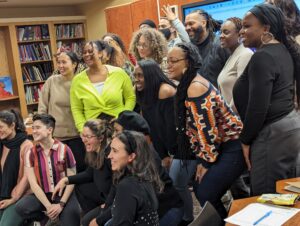
Brooklyn Equity Fellows meet in person for the first time at the 2024 kick off event in Fort Greene.
Brooklyn communities. I’m loving my multi-year partnership with a Brooklyn Elementary School, where we’ve really been able to commit to locally derived inquiry through the lens of joy and justice (see some of our work here…they were the first entry in this Joyful Noise blog!). While I got to start my day celebrating Lunar New Year with them, I got to end my day with an equally beloved community in Brooklyn– Equity Fellows. This will be me and Cornelius’ FOURTH year in partnership with this brilliant group of folx, and our work there is held very much by the Community Up Model , where all the people on the team; District folx, teachers, paraprofessionals and us, work in horizontal leadership to create something more powerful than many of us have experienced in our own professional lives.
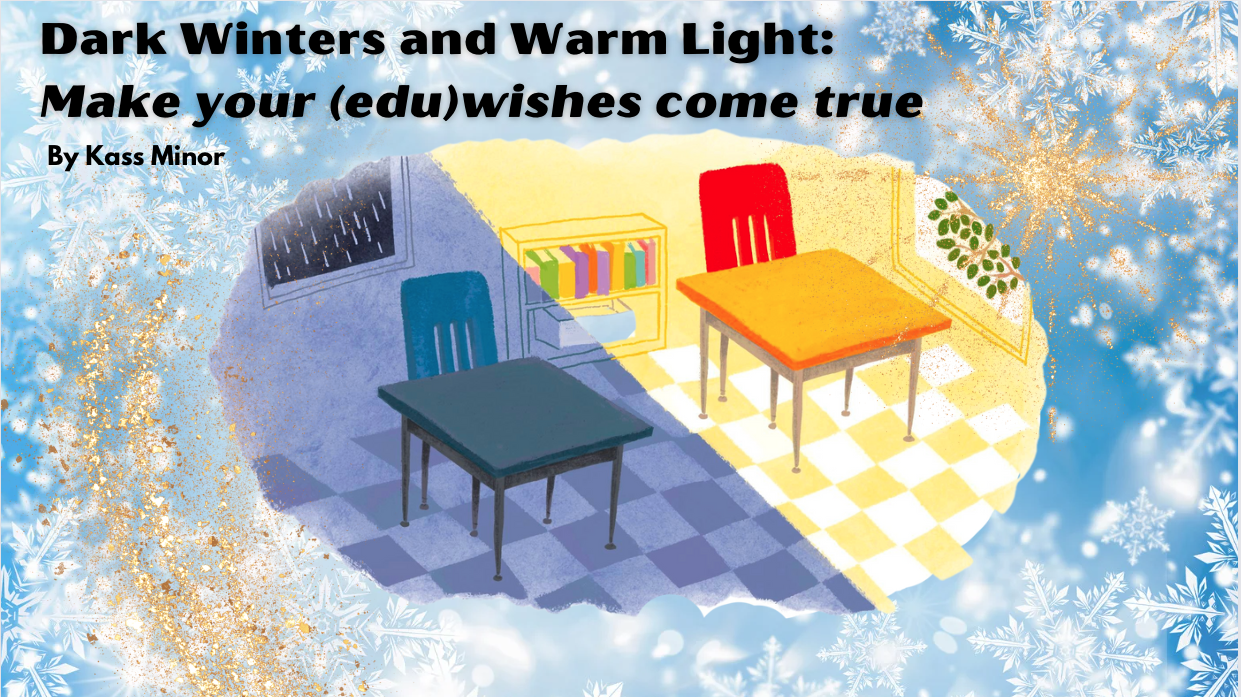
|
My youngest child has an incredible new drama teacher at her school, a retired theatre director who chose to return to school for the love of the game. So, we are used to her super splendid stories re: fantastical dramas (she is currently a witch named “Crispinella”) being shared at our dinner table. But then one day she told us that her class was developing a production of The Never Ending Story, (yes, THAT Never Ending Story) and I almost dropped my fork! Have you ever heard of it? she asked. HAH! Cornelius and I, of course, were intrigued, entertained, and over the moon that her class had access to this cultural milestone, and that night, our family sat down to watch this relic from 1984. We met and re-met Falcior, Atreyu and Morla the Ancient One…but also, we were reintroduced to the “strange nothingness” that threatens their fantastical world. The Never Ending Story’s semi-trustworthy fan wiki-page reminds us about The Nothingness: The Nothing is the main antagonist in The Never Ending Story. It is a power which destroys Fantastica one by one by absorbing it. But in truth is the result of humans no longer believing in the world of fantasy without their beliefs fantasy is disappearing leaving Nothing behind. A darkness makes their world as they know it disappear because the people of Fantastica stop believing in something greater than themselves. Because school is always the B-tape playing in the back of my mind, I couldn’t help but make the analogy: our world of literacy, education, and teaching as we know it is threatened by darkness too… I am not a nihilistic person, and that is not what this note is about. However, the state of our schools and our world begs us to ask ourselves and one another: What are we bearing witness to? In classrooms, in meeting spaces, in the halls of schools? What are we bearing witness to in our streets, in our neighborhoods, in our country, in our world? At this point in the year, I do not think it makes sense to list what we witness; to fall in love with naming all these problems…can feel unbearable, especially in the dark of the winter. And because this is the Season of Hope [insert *Winter Solstice-Hannukah-Advent-Christmas-Kwanzaa-Lunar New Year-simply existing*], I also invite you to choose an element from that Future Goodness column and make an edu-wish [aka “goal” in school spaces or “New Years Resolution” in friend space]. For now, just make a wish. Rest on it during your days off. Let it marinate in your dreams. And then, THEN, when we all return in January, we’ll work together to strategize and make your wish come true. *Make your wish come true zoom invite below! To that end, in this season of hope and hereafter, may we all find rest, may we all lean into care, and may we all find a way to love one another in this fraught, yet hopeful world. Love, Kass Minor *Join Kass for an evening of warm light (via zoom) where we not only discuss your 2024 edu-wishes, but also work together in our Teaching Fiercely community to strategically make them come true! Free, Jan 4PM 2024 EST. |
|
Love, Kass Minor |
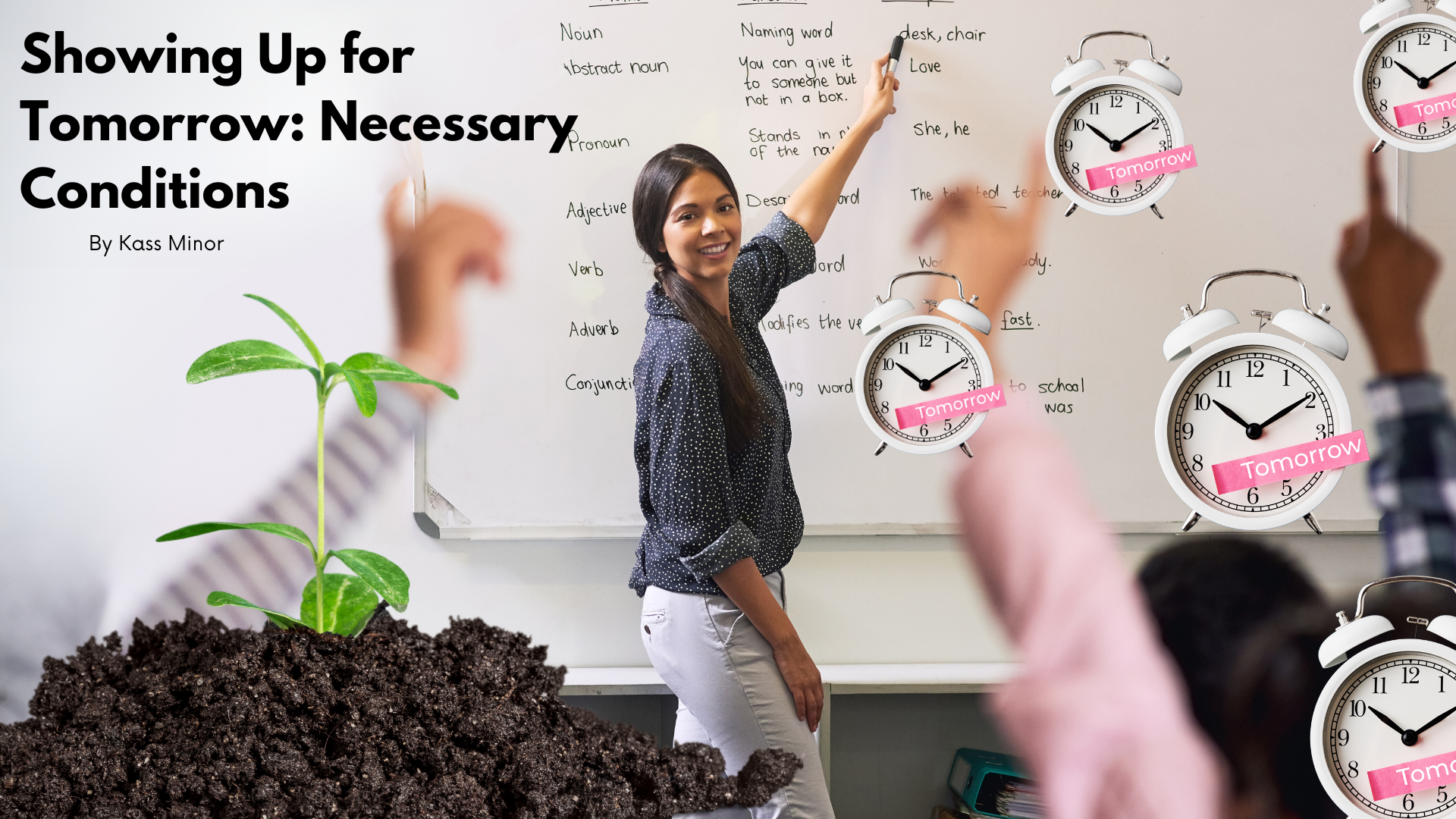
I left the last days of the school year with two tantamount goals in mind. I wanted to:
a) Figure out how to develop robust spaces for deep reflection in learning communities (thought sanctuaries)
*WHILST*
b) Learning how to develop stronger boundaries for my own deep reflection.
I spent all summer ruminating: how is this possible, when the system requires so much of us, so much of me? So I turned to books and art, to people and to past ideas and most recently, to rest. So far, I’ve been able to figure out a few things based on my summer experiences:
Sometimes “the work” is not “work”.
Creators often talk about how they have to live life before they can develop new TV shows or comedic routines, etc. The same is true for educators: We can’t always be reading about teaching and learning to feel inspired to create new kinds of practices with our students and with each other. So this summer, I leaned into that idea, HARD. I read great novels and okay novels. I went to Broadway shows, I went to outdoor concerts, I played new card games with my kids. I sat next to Cornelius and didn’t talk about school. Not all of my experiences will connect to my future endeavors, but it felt good to expunge the energy of yesteryear, and to feel new vibes emerging for collective learning (more to come!)
Educators ≠ System*
So, I didn’t completely remove non-fiction from my life. In the previous newsletter, I talked about my priority summer read, Rest is Resistance: A Manifesto by Tricia Hersey, founder of The Nap Ministry. While this book is chock-full of gems, one of Hersey’s ideas includes I don’t belong to the systems. They cannot have me. (2022, p. 26). As so many of us traverse systems all across our lives, but especially school, remember: You are not the system, and as educators, we have powerful abilities to undo harm and create new opportunities for ourselves and for our students to thrive. *Note: There is also tremendous probability that educators will replicate harm if they are not conscious and aware of systems power!
Boundaries are contagious.
I recently had an opportunity to learn from Dr. Bettina Love, whenshe discussed her new book, Punished for Dreaming: How School Reform Harms Black Children and How We Heal, to a group of NYC educators from Brooklyn and Harlem. Dr. Love talked about the tremendous energy communities expend when they work towards undoing harm to build inclusive, abolitionist schools that heal. Love drove home a major point: if you’re not taking care of yourself, developing your inner life, and doing the mirror work, no kind of honest healing is going to happen. That said, you must draw the line when you are done engaging with people at school. Boundaries are required, and they manifest differently for different people. Maybe for you, it’s not checking email after 5PM. Maybe it’s removing your phone from your bedroom at night. For me, it means no meetings after 7PM. Dr. Love provided testimony too: once one person in the community commits to a boundary and sticks to it, other people feel compelled to do the same.
Proclaiming that thought sanctuaries are vital to educators’ growth and well-being is one thing, but creating the necessary conditions for those things to happen is a whole ‘nother reality. As you move into the school year, I invite you to work alongside me, whether it be in spirit, on the internet, or even in real life. Let’s commit to building spaces for deep reflection; the thought sanctuaries we all deserve. Let’s reclaim this profession not just because we should, but because it’s what we love. To do that work, we must experience our lives outside of school, fully; we must understand that we are individuals outside and within the school system; and we must draw boundaries for our rest.
To read more about building thought sanctuaries, check out Chapters 1 and 3 in Teaching Fiercely: Spreading Joy and Justice in Our Schools.
Kenya, We Are Smitten.
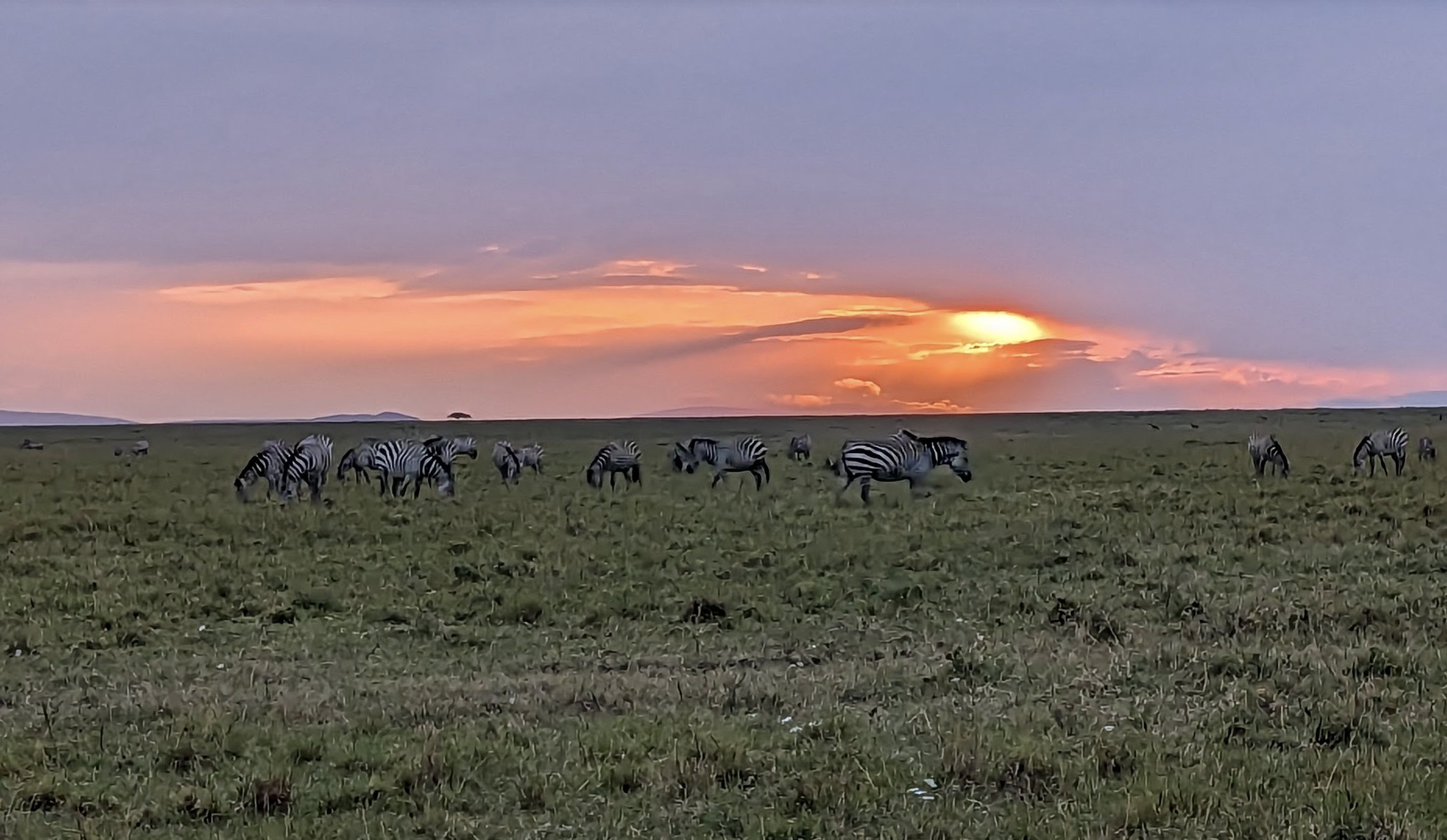
Zebras, in hundreds, as far as you can see. Maasai Mara, Kenya, July 2023
Two days after school was out, Cornelius and I journeyed to Kenya, joining a team of authors, librarians, educators, and visual storytellers, collected by and connected to author Kwame Alexander. For the next ten days, we participated in a cultural literacy exchange hosted by NGO Kenya Connect, spending time in Nairobi, Makutano, Wamanyu, and the Maasai Mara. We left feeling lifted and lighter, having learned beyond the scope of what traditional education offers.
Literacy is this thing many of us educators and parents and people in general get worked up about–whether it be our growing excitement about the series of summer reads we finally have time for, the beautiful development of new waves of teaching and learning we build for classroom life, or even…the piling frustration we experience when our children come home from school not wanting to talk about it. But those who have spent any amount of time unpacking literacy know that it is a precious resource for humanity to consider itself thoughtfully, and that without it, we are in danger of…well, just about everything. [case in point] [case in point] [case in point]
Our trip was centered by the literacy waves we build for kids and teachers in schools, but our trip was illuminated by the love that is woven between humans who share their stories. Between the 14 hour plane rides, jam-packed cargo vans, learning new school culture, teaching on rooftops, dancing before (and after) learning, navigating three languages, meeting lions, warthogs, hundreds of zebras, birthday deep-humming, bitter lemon sodas, collective conversion of schillings to dollars/dollars to shillings, the most epic games of spades, and getting our picture taken 4,002 times, we are now bounded by our love, as well as our literacy.
Part of us feels strange, sharing our trip, our stories, our love with the world. But we are reminded that it is this very sharing of ourselves that grows collective love and understanding between the wider scopes of humanity with whom we are in community with, and those we have yet to connect to.
We wonder–how are you sharing your stories this summer? What or who is being centered? What or who is being illuminated? And how does this sharing [potentially] envelope you with love?
I invite you to peruse the interactive padlet below, peeking into my short photo essay-story: Kenya, We are Smitten.
An interactive Padlet is included below.
A Textual Lineage and Timeline Pedagogy: Widening Perspectives on Asian American Pacific Islander Histories
By Kass Minor
May 17, 2023
Summary: As you develop book lists for the students you teach, or the children you care for, consider honing and probing your own knowledges based on your relationship and understanding of the group you are honoring.
I love that so many educators are inspired and committed to reading representative texts that underscore the diversity of our humanity. Thematic months such as Black History Month, Indigenous People’s Month, Hispanic Heritage Month, Jewish Heritage Month, and Asian American Pacific Islander Heritage month are all powerful in centering people who have not been represented equitably in our schools or society. May is AAPI Heritage Month.
As I think about the learning students experience by interacting with these texts, I wonder how educators are learning the histories, events and experiences that contextualize each book. For example, I recently spoke with a teacher who witnessed a Social Studies exhibition where her own children presented projects based on the lived experience of Indigenous peoples. We reflected together about how different, and far more truthful, kids’ learning about Native American lifeways are now versus what we learned going to school in the 1980’s. How can we work towards accuracy and thoughtfulness when we plan our shared literacy experiences? First, we can start from a place of honesty, and that often requires us to admit what we don’t know.
As you develop book lists for the students you teach, or the children you care for, consider honing and probing your own knowledges based on your relationship and understanding of the group you are honoring. One way to do this is through text-based experiences, both in life and in books. In the example above, I used Alfred Tatum’s concept of textual lineage to evoke my own journey in working towards a deeper understanding of AAPI histories. This type of reflection can lead to text-based classroom experiences that are shrouded in care, lending themselves to more thoughtful conversations within your community-whether they are children or adults.
Consider engaging in a textual lineage experience during in-school meeting spaces, like a grade team meeting or whole-staff professional development. You may even consider doing this work before launching a unit, or planning text sets (We Need Diverse Books and I’m Your Neighbor Books are great starting places to find themed text sets) before a themed unit begins. Alfred Tatum offers excellent resources to do textual lineage work via Learning for Justice.
This work is also an iteration of Timeline Pedagogy, the idea that to move forward, you must look back. I write about it extensively in my new book, Teaching Fiercely: Spreading Joy and Justice in Our Schools.
Celebrating Cornelius in Community
May 8, 2023 (Today is Cornelius’ Birthday!)
Cornelius breathes so much life into this world, and he does it with so much care. Let’s celebrate him as much as he celebrates all of us. Please leave a message, an image, a memory, or even a simple “Happy Birthday” with your name on the padlet below so he can experience bundles of joy from the incredible community that surrounds us. The link will close at midnight tonight!
Leave a message for Cornelius using the linked padlet below!
Something Feasible: A Bite-Sized Approach for Professional Learning and Student Engagement
April 5, 2023
By Kass Minor
Summary: Within the first five minutes of class, the communal space generated between teachers and students can change the trajectory of students’ next forty minutes of learning.
In the enormous sea of possibility that ebbs and flows throughout schools spaces, I find myself and my edu-family feeling overwhelmed as we search for ways to motivate and engage students. There are thousands of ways to move forward to create an environment that cultivates engagement, but which are the most impactful, developmentally sound, student-centered, and culturally relevant?
We think deeply about powerfully revised curriculum, thoughtfully about implementing restorative practices, and attentively about how to deliver targeted instruction. And we question how to leverage those teaching and learning shifts so students learning and engagement is sustained at school. But we often find ourselves skipping over an important aspect of that work: what is feasible?
Not everybody (including myself!) has the headspace to soak in all the possibilities of what could be given daily school life and all the wondrous yet harrowing variables that come with it. Teachers do not have programs that allow for hefty changes in their curriculum to take place immediately, and school leaders find themselves continually understaffed. Students find themselves both at peace and odds with the daily routine of school.
So, lately, I’ve been embracing bite-sized learning for all people, even for us adults. I’m not suggesting that we do away with investing in longterm changes for the way we teach and how school goes, but I am suggesting shifting how we implement new and/or revised practices towards student engagement in ways that are more manageable. Launching an entirely new curriculum or behavioral initiative can be a multi-month and many PD hours-long process, but in the mean time, what if we first just focused on… the first five minutes of class?
When special emphasis is put on the first five minutes of class, the communal space generated between teachers and students can change the trajectory of the next forty minutes of learning: student attentiveness is more likely to initiate and engagement is more likely to be sustained.
The idea of first contact underscores the first moments at the start of class when teachers and students interact with one another, when students first sit alongside their peers, and when everyone in the community first experiences the classroom environment together that day. To enable more powerful engagement in ways that feel manageable for students, teachers, and school leaders, I created these bite-sized steps below to amplify the importance of the first five minutes of class.
Three Things to Pay Attention to for the First Five Minutes of Class
- Help kids revise their energy as soon as they enter your classroom
- Stand near the classroom entrance and model a strong, yet warm presence. This looks differently pending one’s personhood, but the most important factor of first contact is the genuine regard students feel from their teacher.
- The sensory experience of classroom spaces matters. Consider lowering the lights, playing soft music, or even showing the “Lofi Chillhop” youtube channel playing on the Promethean background.
- If students bring in negative “hallway energy” into the first moments of class, consider your behavior first to deescalate their energy. Fritz Redl’s strategies (below) are simple yet powerful ways to reposition potential disruption.
| Deescalation strategies adapted from Fritz Redl:
• Offer limited choices • Use an “I” statement • Name the feeling • Use humor • Drop the expectation for now • Ask, “what can I do to help you?” |
2. Initiate Positive Conversations and/or Nonverbal Affirmations
- Acknowledge students as they enter the room with a “good morning/afternoon”, a smile, or a fist bump. Welcoming and greeting each student by name shows effortful care.
- Appreciate your students and/or colleagues-notice their presence and/or contributions such as “I’m so glad to see you today,” or “thank you” when students raise their hand, or even when they redirect their behavior. Low-stakes appreciations are especially important for students who don’t appear to feel a great amount of success in your class or who have an adverse relationship to school.
3. Introduce an accessible task. One way to develop your affirmation skills is to make hashmarks for yourself each time you affirm your students, or you can have a colleague visit your classroom with that same lens to help you track your affirmations. Ideally, throughout the class period, every student will have experienced an affirmation at least once. For example, if there are 25 students in your class, you would aim to deliver an affirmation once every two minutes.
- Ensure there is a warm-up that is clear and doable for every student. The function of a “warm-up” or “do now” is to prime students for learning in a communal space, and create an entry point for the lesson objective, not to stump your students. Highly visual information that connects with kids’ schemas is often a great combination for engaging and accessible warm-ups.
- Anticipate the accommodations needed for students to access the task. When students enter the room, the task should be accessible for all of your students. For example, if you have one child with a print-based disability, create heavy visuals to support the students’ comprehension, ensure the task is read aloud, or develop a clear routine to support them in knowing what to do. If there are only words in print to describe the task, you risk almost immediate disengagement.
- If your warm-up includes a homework check, anticipate that some students may not have their homework. Plan for an alternate warm up, or if there is more than one teacher in the classroom, review or pre-teach concepts that are relevant to the day’s learning with those students.
To learn more about developing school-wide inquiry on joyful learning, check out Kass’s book Teaching Fiercely: Spreading Joy and Justice in Our Schools, releasing May 2, 2023.
“Joy” Can Be Another Edu-buzzword, Or It Can Be Real
March 25, 2023
By Kass Minor
There are days where my “why” in the work of teaching and learning is re-affirmed, and yesterday was one of them.
Thanks to PS 94, Principal Christina Gonzalez, Assistant Principals Rose, Doris, Jean Marie, Sharon, Instructional Coach Ashley, and all the educators and kids and families who’ve fostered a community where something like joyful learning can manifest, with intention–with a research base and personal commitments, wide-scale.
Recently, we continued our inquiry into joyful learning. This inquiry was, and continues to be communal, underscored with questions and possibilities generated by the community, and overall, very buzzy!
First, we created local and shared understanding on what Joy meant for the community, collectively. [No one person, especially from the outside, can pose their ideas of joy onto a people. It’s gotta be co-constructed.]
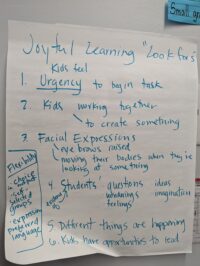
Educator micro-communities work together to co-construct their understandings of joy as it can manifest in classroom space.
Then, we tackled our conceptual understanding of it really means to learn in a space like school. “Learning in school” might seem like a no-brainer, but many times what we see is compliance and performance as opposed to deep, authentic learning.
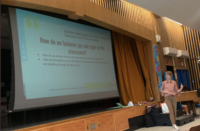
Kass parsing out big questions generated by the community on possibilities for balancing joy and rigor within classroom spaces.
We grappled with balancing standards, student-centeredness and joy. We interrogated the term “rigor”. [Spoiler: rigor does not mean super hard and challenging-rather, it means that you are teaching within a child’s ZPD and are using their schema and personhood to develop new understandings]
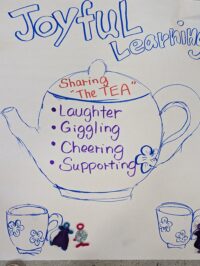
Teachers used various representations and visual art to document their co-constructed understandings on joy.
We self-identified how, when, and why people in school [including teachers] experience adrenaline-based learning vs. joyful learning.
Finally, we co-constructed community understanding of attributes of joyful learning as they already manifest, or could manifest, in PS 94 classrooms.
During this time, the whole community worked in micro-communities, used lots of different materials, including play dough, pipe cleaners, charts, markers. Some groups even performed construction of joy using drama and tableau.
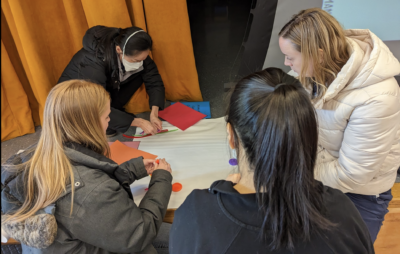
Educators work in micro communities to co-construct their understandings of joy it manifests in classrooms within their larger community.
Long story short: Inquiry-based learning is beautiful. Joy can be a buzzword, or it can be real. To do the work of scaling up something as powerful and human-centered as joyful learning, the whole community has to be a part of the initiation and investment of the inquiry-based journey. Local and collective understanding is key.
——
To learn more about developing school-wide inquiry on joyful learning, check out Kass’s book Teaching Fiercely: Spreading Joy and Justice in Our Schools, releasing May 2, 2023.
“It was a magical day at 94. In looking at the work the staff engaged in together and as we use this work to deepen our understanding of what it means to provide meaningful experiences we are understanding that joy is well deserving and only takes place when is co-created with our teams and our students. I am so excited for the work ahead of us!”- Cristina Gonzalez
[/fusion_text][/fusion_builder_column][/fusion_builder_row][/fusion_builder_container]
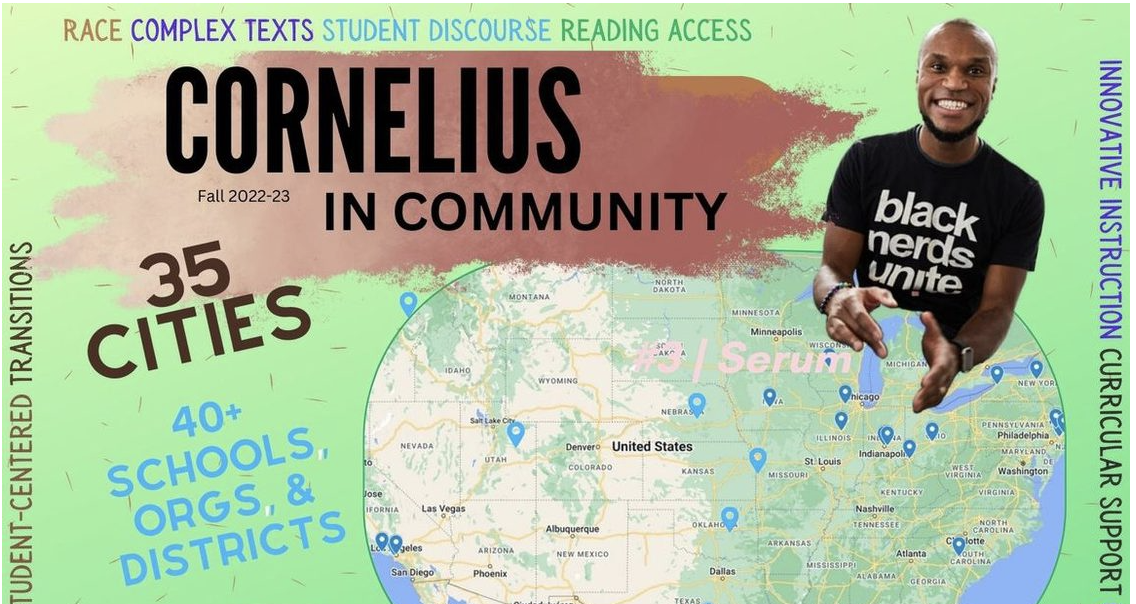
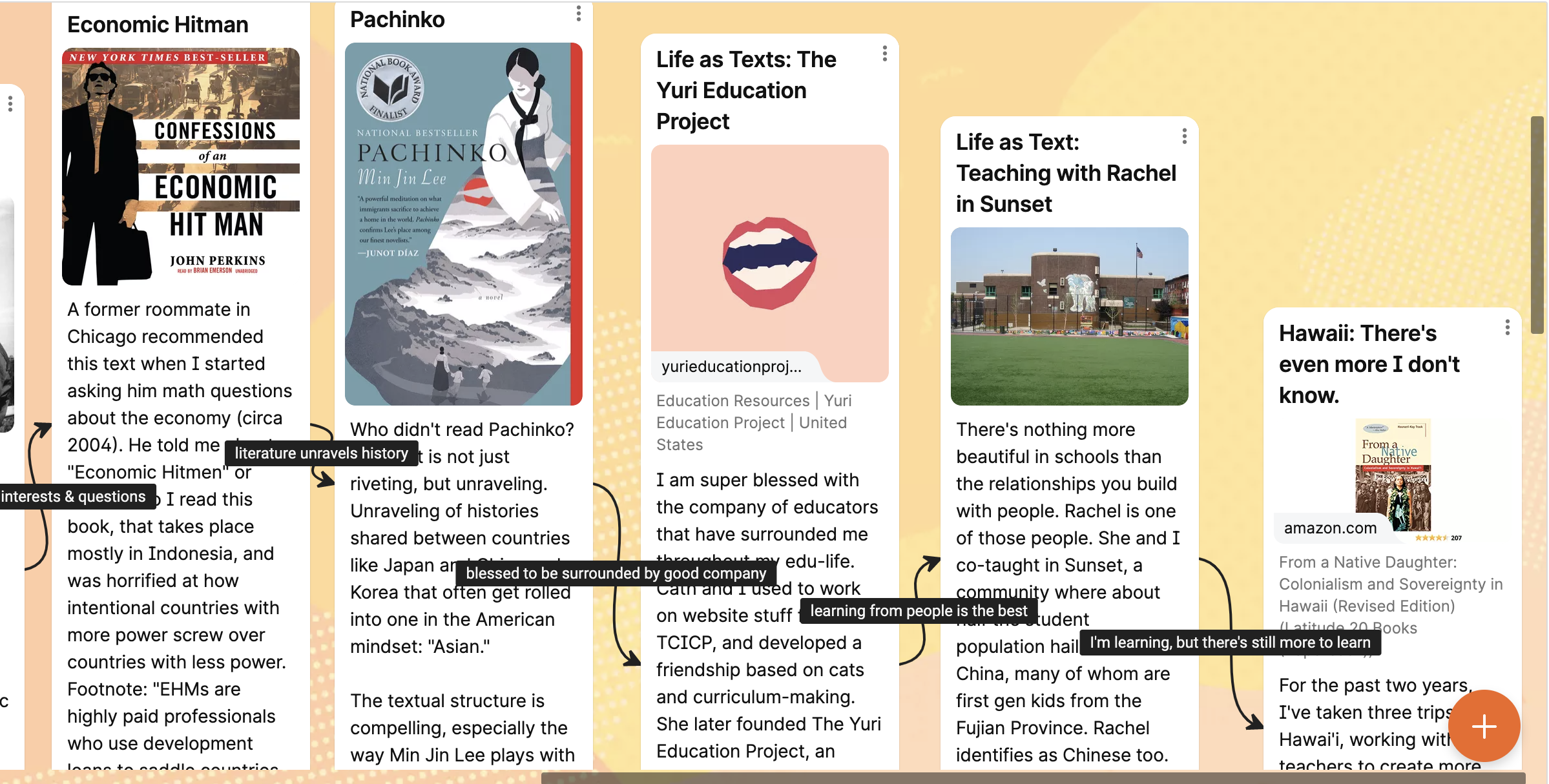
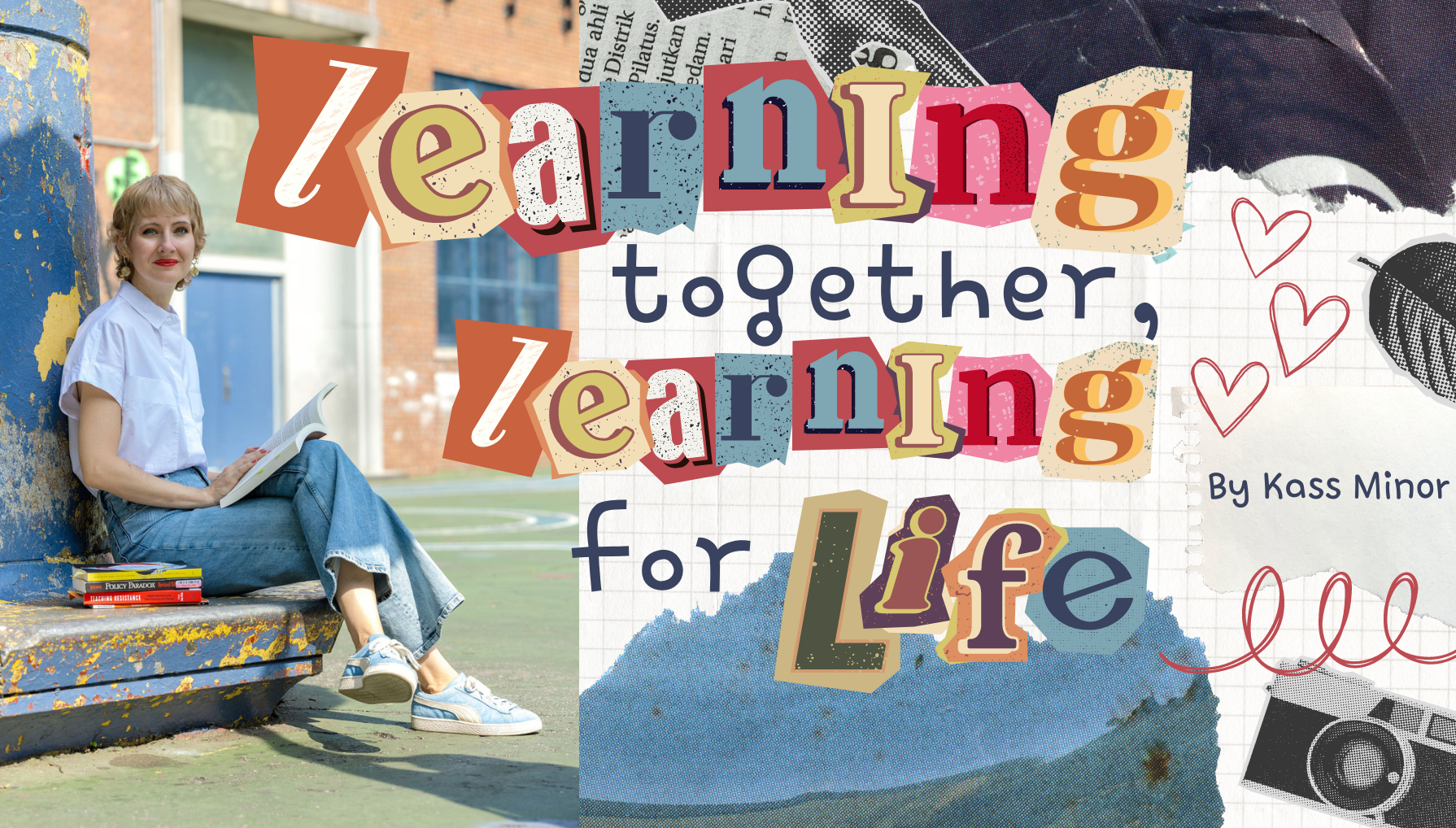

 I do, however, invite you all to reexamine (or just ‘examine’ if you have not already) the Structured Generator of Hope that is offered in Teaching Fiercely’s beginnings (also featured to the right). If you can, find a friend to warmly interact with the framework.
I do, however, invite you all to reexamine (or just ‘examine’ if you have not already) the Structured Generator of Hope that is offered in Teaching Fiercely’s beginnings (also featured to the right). If you can, find a friend to warmly interact with the framework.